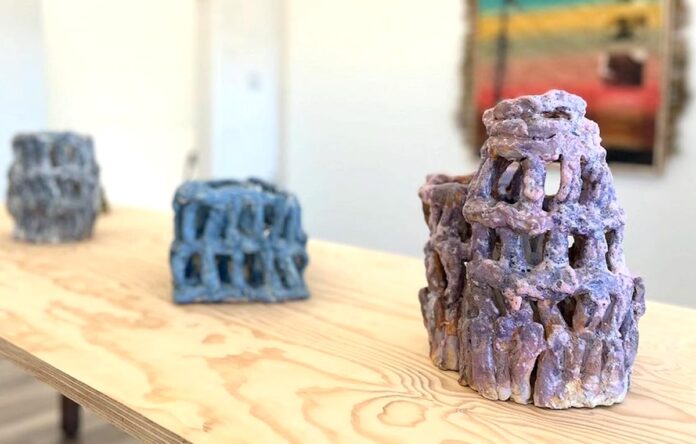Nocturnes (through September 1 at Personal Space, Vallejo) conjures poetic combinations of materials and alternative epistemologies through connections with nature, in an exhibition celebrating the one-year anniversary of an artist-run gallery that’s already situated itself as an important part of the wider Bay Area arts scene.
It might have to do with the fact that I traveled to Vallejo by ferry, but I arrived to Personal Space feeling like a tourist, even though I was just an hour away from home. The building’s light pink façade is adorned at the base with striped tiles in butter yellow and maroon. A sign on the exterior of the building, held up by curly wrought-iron supports, features a checkerboard in blues, black, and white covered with pictorial glyphs.
The sign’s image rotates with every new show. In this case, Evening Thoughts by Ocean Escalanti functions as a rebus cryptically previewing what’s to come inside. A mosaic of vaguely disquieting thoughts before your head hits the pillow, combined with the mysterious quality that emerges between dusk and dawn, starshine and clay, where one’s mind opens up to new ways of seeing and understanding.
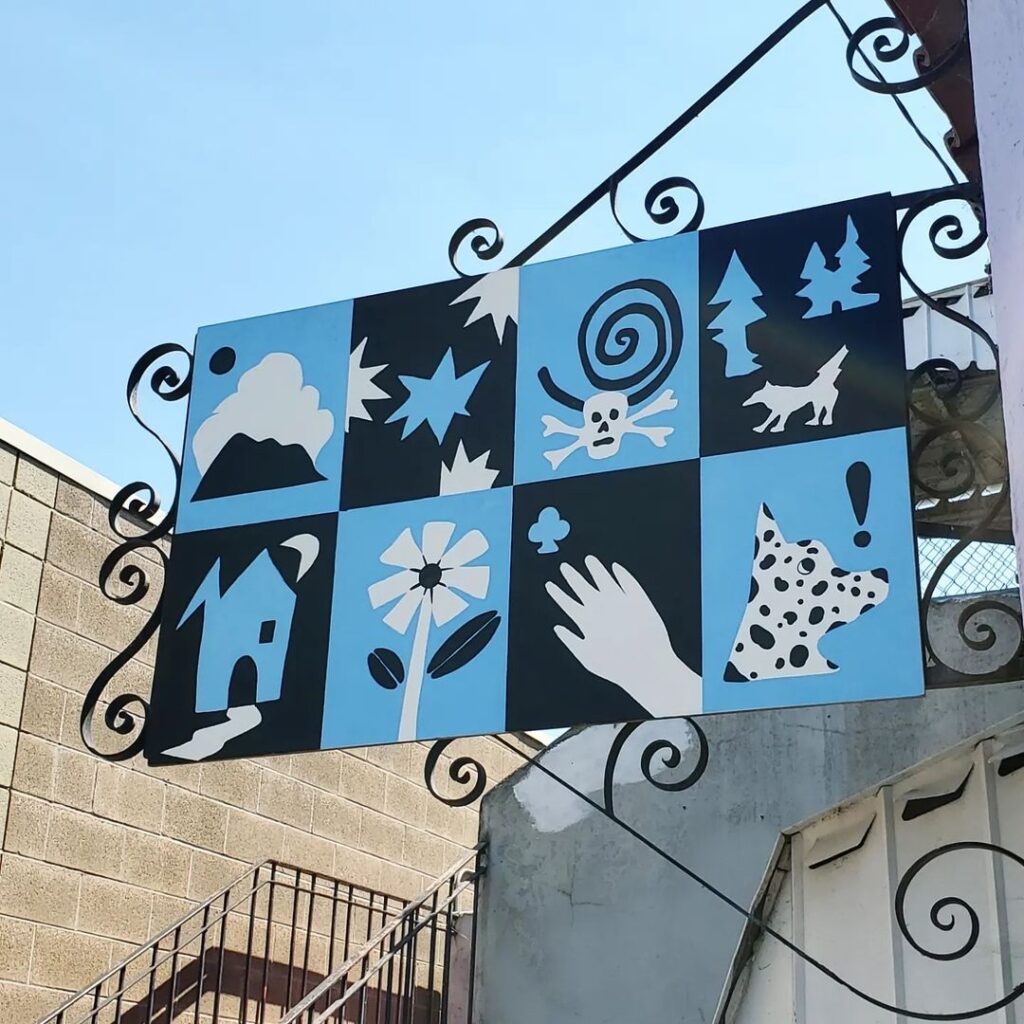
The eight-person group show in the main gallery space features work from several local artists: Escalanti, Sylvia Fragoso, Nancy Nguyen, yétúndé olágbajú, bringing their work into thoughtful conversation with artists from further across the country and abroad: Rachel Frank, Aida Lizalde, Alicia Reyes McNamara and Zipporah Camille Thompson.
One of the things that stands out about the artists in this show is their sensitive use of materials, how they are combined in unexpected ways and transformed.
Situated on a large plywood table in the center of the first room are Sylvia Fragoso’s layered and tactile hand-built ceramic sculptures, crafted out of cylindrical coils stacked and squished together to resemble scaffolding or the ruins of an ancient city. Fragoso’s armatures pay tribute to religious and domestic places she’s visited, carving out space for spiritual contemplation through her networked configurations of clay.
This liminal zone, existing somewhere between dismantling and rebuilding is an important refrain materially and conceptually in Nocturnes, as is connecting to a sense of spirituality through nature.
Rachel Frank’s Rewilding offering hand, oysters, is a giant hand shape cut and sewn from a large piece of blue jacquard fabric with contrasting red veins, embellished with sculpted ceramic oyster shells. This work is part of a larger series that obliquely pays homage to different environmental projects in New York City: This specific hand references oyster-shell reefs created in NY Harbor to restore habitats for hundreds of species, simultaneously guarding against increased flooding and erosion exacerbated by human-driven climate change.
Help us save local journalism!
Every tax-deductible donation helps us grow to cover the issues that mean the most to our community. Become a 48 Hills Hero and support the only daily progressive news source in the Bay Area.
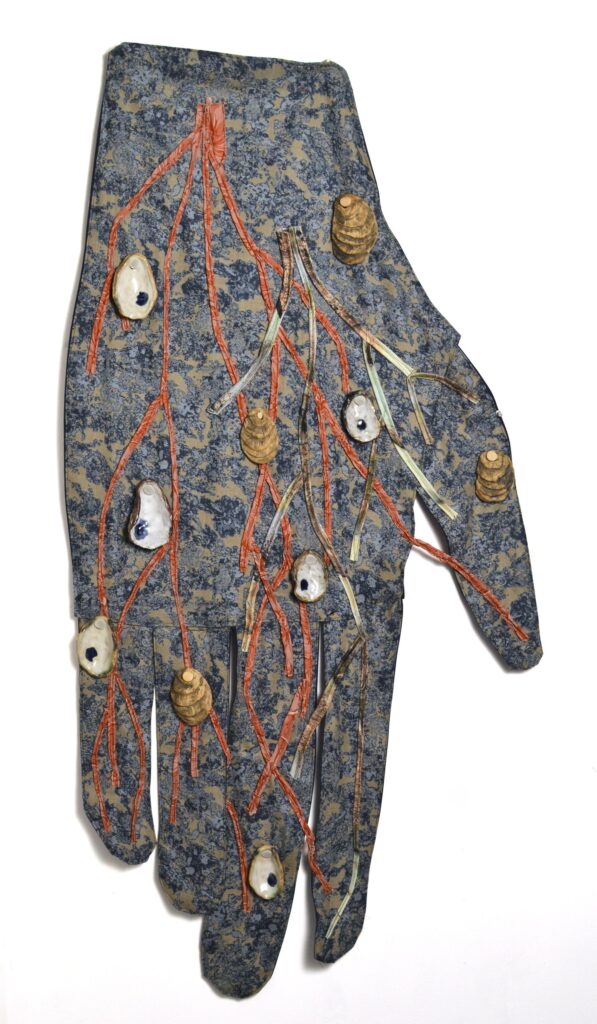
According to the non-profit Billion Oyster Project, “it took less than 100 years for New Yorkers to wipe out the oyster population in New York Harbor.” There is something both haunting and beautifully cyclical that those same shells are being “offered back” to the harbor in a configuration that will hopefully help the species and the surrounding landscape bounce back. Frank’s move as an artist here isn’t prescriptive, but sincerely emphasizes the beauty and poetry of restorative approaches, quietly posing the questions: What if we already had what we needed to repair the damage that’s been done? What if a small gesture of concern isn’t small at all?
yétúndé olágbajú’s piece expands upon this idea of reverence for the past as a way to move forward within their work. sankofa (clay, starshine, sweetgrass) is a digital collage digitally printed on fabric, an ombré spectrum of colors quilted with swirling stitches and surrounded by a wooden frame that’s been punctured around the perimeter with tufts of sweetgrass.
The idea of sankofa (often symbolically depicted as a bird looking backwards as it flies forwards) also has another visual manifestation (a heart with swirls on interior and the end) which olágbajú conjures in their collage with image of wrought iron structure reaching upward formed out of this repeating heart shape, reaching up towards the heavens like a monument.
The collage also contains text from Lucille Clifton’s poem “won’t you celebrate with me.” All of these visual elements combine with fragments of self-portraits, bodies, and landscapes to create a song of the artist themselves. The bundles of sweetgrass bring plant matter into the gallery space, and also form somewhat of a spikey protective shield around the soft, puffy, vulnerable interior of the quilted work inside the frame, serving as a reminder that natural materials contain wisdom, if we can just manage to listen.
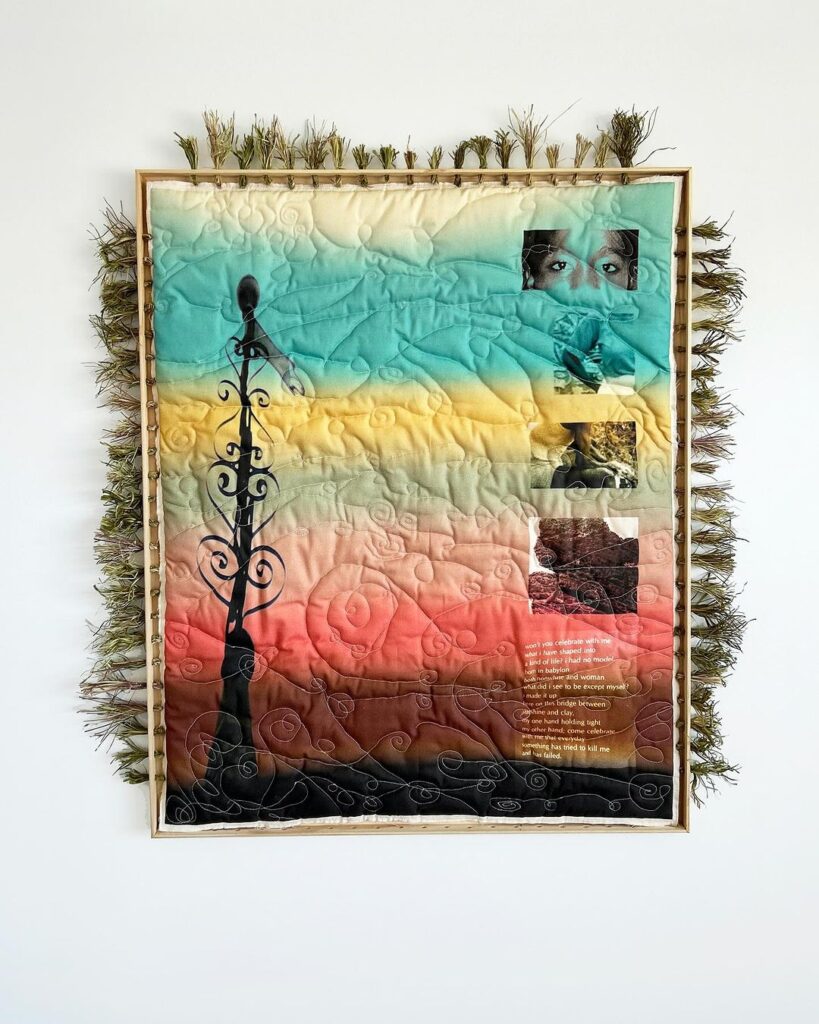
Elsewhere in the exhibition, Ocean Escalanti also uses the material form of quilting as a container for ideas. The two panels of quilt I Dared to Knock at the Door to the Cosmos, installed vertically like an entryway, incorporate blue cyanotype-treated fabric containing an image of silhouetted plastic animal figurines surrounding an ornate grate.
Nancy Nguyen’s paintings continue pulling at the thread of nature as a conceptual portal to an imaginative spiritual space, where the edges of forms are soft and the colors are murky, as if the pigments were collected from plant matter themselves. The combination and exciting slippage between so-called natural and human made/industrial elements keeps repeating in Nocturnes as well. In Aida Lizade’s works, bulbous terracotta ceramic vessels that resemble udders or various human body parts are suspended from the ceiling with retired fire hoses to form a sort of tenuously balanced and porous corporal system.
The aura of galleries like Personal Space, which are created by artists, is distinct and refreshing from institutions more entrenched in red tape and hierarchy. The gallery doesn’t sacrifice professional lighting and preparator-level hanging, and retains subtle, domestically coded reminders—like arched architectural details—of the space’s many past lives. Bonus art hanging in the bathroom and a denim-clad stool for resting cultivate a more familial environment, and allow us a sense of what it’d be like to actually live with this art.
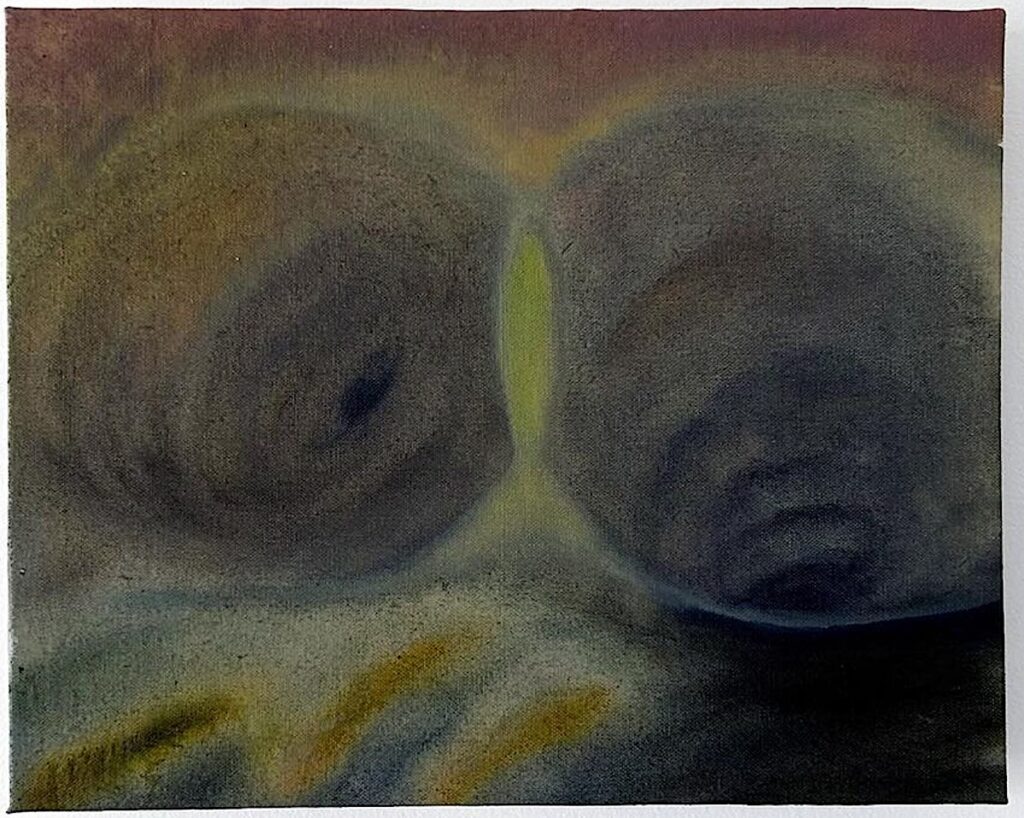
Not to mention a different attention to networks of artists from an on-the-ground vantage of someone actually living and making in this town—Personal Space founder and director Lisa Rybovich Crallé—offering a perspective which privileges intuitive connections between concepts and materials, celebrating art for art’s sake, but also the artists behind the work that make to live and live to make.
Cralle’s commitment to fostering artistic community stretches into the back room of the space, which contains a store filled with limited edition objects, wares, and zines by local artists, as well as the more work of artists who are currently exhibiting work in Nocturnes. There you can find pamphlets on local foraging and dyeing with plants by Escalanti (which I regret not purchasing in my rush to catch the ferry home) among other exciting small works created by Vallejo-based heavy hitters like Ajit Chauhan. The shop gives meaningful context to the crafts of artists that support their work, offering up other opportunities for foregrounding the continuity between life and art, and a platform to showcase how these makers work in relation to one another.
It’s clear we need more of these artist-run spaces in this city, and to support the spaces that already exist (like Your Mood, Cushion Works, House of Seiko, etc.). Might I suggest that you make a day of it, and follow some of the recommendations that the gallery lists for other food, drink, and activities in Vallejo.
NOCTURNES runs through September 1 at Personal Space, Vallejo. More info here.


